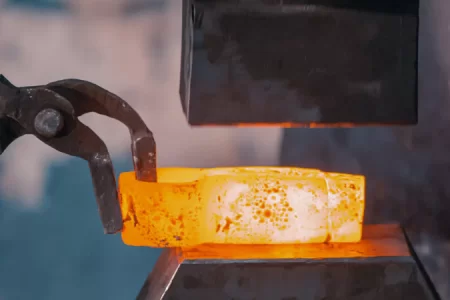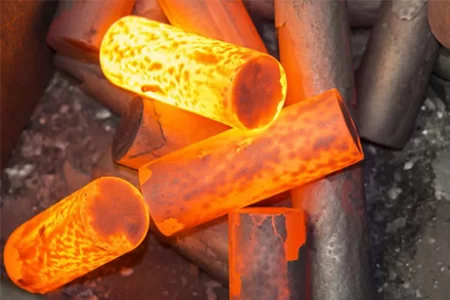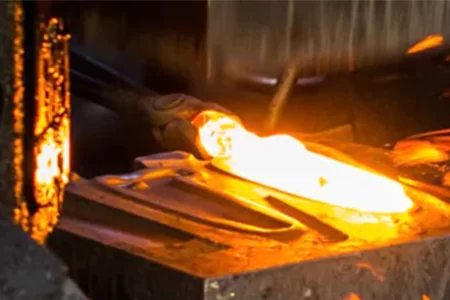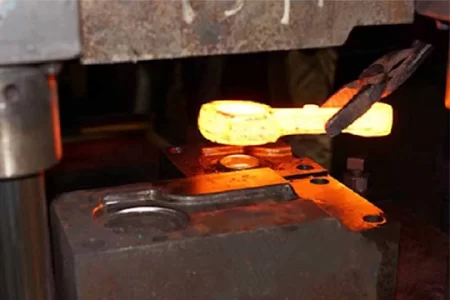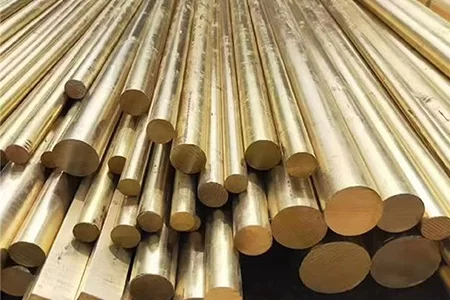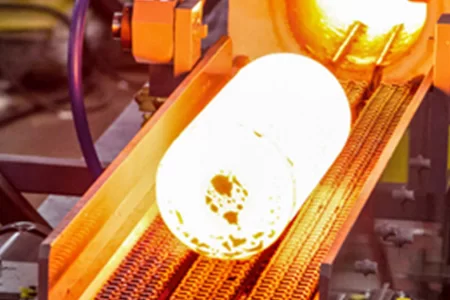By sharing knowledge, experience and views in the field of forging technology, we help you understand, learn and apply relevant technologies.

Hulk Metal Forging Technology
Share technical experience
-
Home>
-
Blog>
-
Technology>
In-Depth Understanding of Stainless Steel Forging

Stainless steel, known for its exceptional corrosion resistance, high strength, and excellent workability, is widely used in various industries. Forging is a crucial manufacturing process that enhances the mechanical properties of stainless steel, making it ideal for demanding applications. By precisely controlling the forging process, manufacturers can significantly improve the strength, durability, and performance of stainless steel components. This article provides an in-depth exploration of stainless steel forging processes and their applications across multiple industries.
Basics of Stainless Steel
Definition and Classification of Stainless Steel
Stainless steel is an iron-based alloy that contains at least 10.5% chromium (Cr), forming a protective chromium oxide layer on the surface that enhances corrosion resistance. Based on its metallurgical structure, stainless steel can be classified into the following three main types:
Austenitic Stainless Steel:
Contains chromium (Cr) and nickel (Ni), with grades like 304 and 316. It offers excellent corrosion resistance and weldability, making it suitable for chemical processing and food industries.
Ferritic Stainless Steel:
Has a high chromium content but little to no nickel. Common grades include 430 and 446, which are widely used in automotive exhaust systems and architectural applications.
Martensitic Stainless Steel:
Contains higher carbon content, providing increased hardness and strength. Examples include 410 and 420 stainless steel, often used in knives, turbine blades, and other high-strength applications.
Chemical Composition and Its Effect on Performance
The properties of stainless steel are influenced by its chemical composition:
Chromium (Cr):
Enhances corrosion resistance and oxidation resistance.
Nickel (Ni):
Improves ductility and toughness.
Carbon (C):
Affects hardness and strength but may reduce corrosion resistance at high levels.
Molybdenum (Mo):
Increases resistance to pitting and crevice corrosion, commonly found in 316 stainless steel.
Stainless Steel Forging Process
Material Preparation Before Forging
To ensure the quality of forged stainless steel components, raw materials such as steel ingots or billets undergo ultrasonic inspection to detect internal defects before processing.
Heating Stage
Proper temperature control during heating is essential for successful forging. Different types of stainless steel require different forging temperature ranges:
· Austenitic Stainless Steel: 1100~1250°C
· Ferritic Stainless Steel: 950~1150°C
· Martensitic Stainless Steel: 1000~1200°C
Protective atmospheres or anti-oxidation coatings are often used to prevent oxidation and decarburization during heating.
Forging Process
· Open Die Forging: Suitable for large components, offering flexibility but requiring additional processing.
· Closed Die Forging: Provides high precision and is ideal for mass production of complex parts, such as automotive and mining equipment components.
· Roll Forging: Used for elongated components like wire grip clamping parts.
Cooling Process After Forging
Post-forging cooling significantly impacts the final microstructure and properties of stainless steel. Rapid cooling prevents grain coarsening and enhances toughness, while controlled cooling reduces internal stress and minimizes cracking risks.
Heat Treatment in Stainless Steel Forging
Heat treatment plays a crucial role in optimizing the mechanical properties and performance of stainless steel forgings. By carefully controlling temperature, cooling rates, and processing time, manufacturers can enhance hardness, strength, corrosion resistance, and overall durability. The most common heat treatment methods used in stainless steel forging include annealing, quenching and tempering, and carbide precipitation control.
Annealing
Annealing is a heat treatment process that involves heating stainless steel forgings to a specific temperature, maintaining that temperature for a predetermined period, and then slowly cooling the material. This process serves several critical functions:
· Softening the Metal: Annealing reduces hardness, making the material easier to machine and shape in subsequent manufacturing processes.
· Enhancing Ductility: By eliminating internal stresses, annealing improves the material’s ability to withstand deformation without cracking.
· Restoring Corrosion Resistance: Solution annealing is particularly important for austenitic stainless steels (e.g., 304 and 316) as it dissolves carbide precipitates, which can otherwise lead to intergranular corrosion.
Typical annealing temperatures for different types of stainless steel:
· Austenitic Stainless Steel: 1050–1150°C (1922–2102°F) followed by rapid cooling.
· Ferritic Stainless Steel: 750–950°C (1382–1742°F) followed by slow cooling to prevent grain coarsening.
· Martensitic Stainless Steel: 600–750°C (1112–1382°F) to achieve stress relief while maintaining strength.
Quenching and Tempering
This heat treatment is primarily applied to martensitic stainless steels, which require enhanced hardness, strength, and wear resistance.
· Quenching: The steel is heated to a high temperature (usually 950–1050°C), followed by rapid cooling in oil or water to trap carbon in the martensitic structure, significantly increasing hardness.
· Tempering: To reduce brittleness and improve toughness, tempered stainless steel is reheated to a lower temperature (200–600°C) and then slowly cooled. The exact tempering temperature depends on the desired balance between hardness and ductility.
Common applications of quenched and tempered stainless steel include cutting tools, industrial blades, and high-strength mechanical components.
Preventing Carbide Precipitation
Carbide precipitation occurs when stainless steel is exposed to temperatures between 450–850°C, leading to chromium depletion at grain boundaries. This phenomenon, known as sensitization, reduces corrosion resistance, especially in aggressive environments.
To prevent carbide precipitation:
· Solution Treatment: Heating stainless steel to 1050–1150°C dissolves carbides, followed by rapid quenching to prevent their reformation.
· Low Carbon Grades: Using low-carbon stainless steel (e.g., 304L, 316L) minimizes carbide formation.
· Stabilized Stainless Steels: Adding titanium (Ti) or niobium (Nb) prevents carbide precipitation, as these elements form more stable compounds than chromium carbides.
By carefully selecting heat treatment parameters, stainless steel forgings achieve superior mechanical and corrosion-resistant properties, ensuring long-term reliability in various applications.
Precision Machining of Stainless Steel Forgings
After forging and heat treatment, stainless steel components often require additional surface finishing and machining to meet precise dimensional and aesthetic requirements. Various machining processes enhance corrosion resistance, mechanical properties, and overall appearance.
Pickling
Pickling is a chemical process that removes oxidation, scale, and surface contaminants from stainless steel forgings. It involves immersing the component in an acid bath containing nitric acid (HNO₃) and hydrofluoric acid (HF).
Advantages of pickling:
· Restores the original corrosion-resistant properties of stainless steel.
· Removes heat tint and discoloration caused by welding or high-temperature processing.
· Prepares the surface for subsequent coating or finishing processes.
Sandblasting
Sandblasting, or abrasive blasting, is a mechanical process that propels fine particles (such as aluminum oxide or glass beads) onto the surface at high velocity.
Benefits of sandblasting:
· Improves surface uniformity by removing impurities and rough edges.
· Enhances adhesion for coatings, such as paint or powder coatings.
· Creates a matte finish that improves aesthetics and reduces light reflection.
Mechanical Polishing
Mechanical polishing is a process that smoothens the surface of stainless steel forgings using abrasive belts or polishing wheels.
Key benefits of mechanical polishing:
· Reduces friction and wear by eliminating surface irregularities.
· Enhances hygiene by removing microscopic crevices where bacteria could accumulate (important in food processing and medical industries).
· Improves the visual appeal of stainless steel components, often required in automotive and architectural applications.
Depending on the final application, stainless steel forgings may undergo additional finishing techniques such as electro-polishing, passivation, or coating to meet customer specifications.
Quality Control and Testing
Ensuring the quality and performance of stainless steel forgings requires rigorous testing and certification. Manufacturers employ a combination of non-destructive testing (NDT), mechanical testing, and compliance with international standards to guarantee reliability and safety.
Non-Destructive Testing (NDT)
NDT methods detect defects in forged components without damaging the material, making them essential for quality assurance in critical applications.
Common NDT methods used in stainless steel forging:
· Ultrasonic Testing (UT): Uses high-frequency sound waves to detect internal defects such as voids, cracks, and inclusions.
· Magnetic Particle Inspection (MPI): Applied to ferromagnetic stainless steels to identify surface and near-surface cracks.
· Dye Penetrant Inspection (DPI): Involves applying a fluorescent dye to reveal surface defects, especially useful for complex geometries.
Mechanical Performance Testing
Mechanical testing evaluates the strength, hardness, and ductility of stainless steel forgings.
· Tensile Testing: Measures ultimate tensile strength (UTS), yield strength, and elongation properties under tension.
· Hardness Testing: Determines resistance to deformation using methods such as Rockwell (HRC), Brinell (HB), or Vickers (HV) hardness testing.
· Impact Testing: Assesses material toughness under sudden loads, crucial for applications in harsh environments.
Certification Standards
To meet industry requirements and customer expectations, stainless steel forgings must comply with international quality standards.
· ISO 9001: Ensures a consistent quality management system for manufacturing processes.
· ASTM Standards: Defines material specifications, mechanical properties, and testing methods for stainless steel forgings.
· CE Certification: Required for products sold in the European Union to demonstrate compliance with safety and environmental standards.
By adhering to strict quality control protocols and comprehensive testing procedures, stainless steel forgings achieve superior performance, ensuring reliability in demanding industrial applications.
Applications of Stainless Steel Forging
Cable & Wire Grips
Stainless steel forging is essential in cable and wire grip tools, such as tensioning clamps and wire-pullers. These tools require high strength and corrosion resistance to maintain reliability in harsh environments.
Trailer Accessories
Forged stainless steel components, including towing hooks, connectors, and trailer hitches, provide superior durability and strength for heavy-duty applications.
Construction Hardware
Anchors, fasteners, and load-bearing hardware in construction applications demand high-strength stainless steel forgings to ensure structural integrity and long-term durability.
Mining Equipment Spare Parts
Mining equipment parts, such as crusher components and drilling tools, experience extreme impact and wear. Stainless steel forging enhances their durability and reliability.
Forging Parts
Custom-forged components for machinery and high-temperature applications benefit from stainless steel forging's superior mechanical properties.
Metal Exterior Accessories for Car, SUV, Truck
Exterior automotive parts, such as bumper brackets, door handles, and running boards, require stainless steel forgings to ensure corrosion resistance and aesthetic appeal.
Stainless steel forging is a critical metalworking process with applications spanning cable grip tools, trailer accessories, construction hardware, mining equipment, forging parts, and automotive exterior components. As industrial technology advances, the demand for high-quality stainless steel forgings continues to grow. Future developments will emphasize precision machining, material optimization, and intelligent manufacturing to enhance product performance and efficiency.
Article Navigation
Article Navigation
Industries
Foundries
-

July.01, 2024
Difference between hot forging and cold forging
READ MORE
-

June.27, 2024
What are the advantages and disadvantages of the hot forging process?
READ MORE
-

January.18, 2024
Forging: What Is It? What Are The Different Types of Hot Forging?
READ MORE
-

November.29, 2024
What is steel forging?
READ MORE
-

July.30, 2024
What are the materials for hot forging?
READ MORE
-

July.03, 2024
What are the processes of hot forging?
READ MORE



